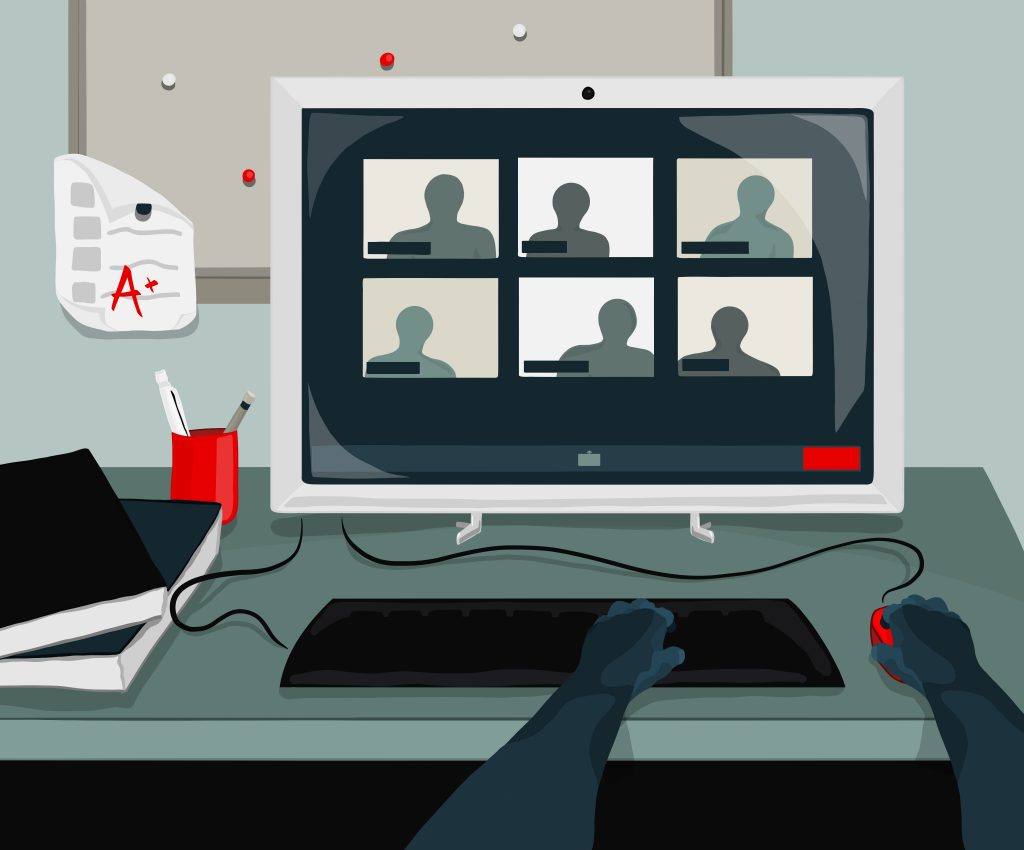ILLUSTRATION BY ASHLEY DEPEW
For years, Fenny Ligito would look at her son Peter’s report card.
As a parent of a child with autism, Ligito made it a point to pay attention to his grades and teacher reports. Each quarter his report card came home in a manilla envelope. Her fingers would trace the envelope before pulling out an exceptional report card. No surprises — Peter once again got all A’s and B’s. No notes from his teachers that Peter had any problems with school work.
It turned out he was not doing so well. Shortly before the pandemic closed down the nation’s schools Ligito discovered that her son, as a fifth grader, was reading at a first-grade level.
His months at home have made a difference.
Ligito, who lives in Philadelphia, said that the transition to remote learning has improved her son’s academic performance. As he attended class by Zoom, she was able to work more directly with him at home.
“I was paying attention to the instruction, the class, the kids’ participation. I was right next to him,” Ligito said of Peter, now 12 and about to enter the seventh grade.
Parent testimonials about the quality of teaching for children with disabilities varies, depending on access to education and parents’ ability to commit time to helping their child with school. According to an October 2020 report from Harvard Health Publishing, remote learning is “less likely to be disrupted or changed over the course of the school year.” That can lessen anxiety for students in special education programs.
The study also acknowledged potential problems: “… students who struggle with attention, intellectual functioning, language, self-regulation, or a combination of these challenges may have great difficulty learning efficiently from a remote platform.”
Other issues arise from historically underfunded special education programs – students may not be able to access computers, Wi-Fi, or specialized tools.
Steven Cohen, a disabilities advocate from Nevada, remembers his experiences with educators in the early 2000s. They didn’t understand his autism diagnosis.
“The child study team just really didn’t know, particularly once I got to high school how to handle it. It’s not understanding that autism is a spectrum, when you’ve met one person, their needs might be different from the next person on the spectrum,” Cohen said.
A report from the Harvard Civil Rights-Civil Liberties Law Review found that students with disabilities “are unnecessarily isolated, stigmatized, and confronted with fear and prejudice.” Experts from Equity and Excellence in Education find that fear and prejudice are magnified by race, gender and ability.
Ligito said her son, because he is comfortable at home, asked questions during virtual learning, when he previously would have stayed silent in order to avoid standing out.
“The class is like 25 people at least, and there’s only one teacher and it slips through,” Ligito said. “My son will not ask for help…Hundred percent he would say no.”
Ligito was able to pinpoint exactly where her son wasn’t understanding content, and was able to bridge the gaps in comprehension.
“For some kids, and particularly some kids with disabilities — actually online learning when it was done well and when it was structured and when it was consistent — some kids actually thrived in that environment,” said Kimberly Caputo, a Pennsylvania attorney who has represented the Ligito family.
Not all parents had a better education experience with their child during the pandemic. Tori Snyder, a single mother of a 3-year-old with autism in Baden, Pennsylvania, said COVID-19 halted his access to speech therapy.
“It was three hours via Zoom and it just wasn’t working right — he had no attention span,” Snyder said.
Even Ligito found that the highs of remote learning came at a cost. Peter, who was previously social, became used to isolation and isn’t as open to socialization.
“He started to lose interest in meeting people. Even if I offer him — ‘Come on, do you wanna meet friends?’ (He says) ‘No, I just want to stay home,’”Ligito said.
What Technology Means for Post-COVID
Technology like Zoom shows flexibility is possible in special education.
“Prior to the pandemic, the school has been doing the same system for so many years, the same way. I think being in the pandemic situation opens up a new game changer,” Ligito said. For “kids with special needs, using an assistive device or technology can [make] them feel more confident … give them more hope.”
The Journal of Special Education Technology found that assistive technology such as screen readers and tablets can help students quickly access information that is crucial to comprehension. Ligito said instant access to more information boosted Peter’s learning as well as his morale.
In some cases, technology helped students communicate. A 2021 study from Johns Hopkins University highlighted the story of students in New York City with autism who found it easier to communicate and look each other in the eye on Zoom.
Technological advances, however, are not perfect. According to a 2020 survey from the American Educator Panels, nearly 86% of students had difficulties with internet access.
Caputo said that historical underfunding for special education programs will continue to affect children with disabilities, both through educational opportunities and education facilities.
“I do think how funds are prioritized was an issue pre-COVID,” said Caputo, who has represented the Ligito family. It “will continue to be an issue until people really begin to see the benefits to the community of what it means to make investments in all kids.”
Caputo hopes that the pandemic showed teachers and administrators that education can be flexible — something that works well for special education programs.
“This concept of, ‘Hey, does education always have to be in a brick and mortar five days a week face to face?’ ” Caputo said. “Maybe the answer is no. Maybe there are ways for public schools to begin to really think out of the box and creatively about education and how it’s delivered.”

